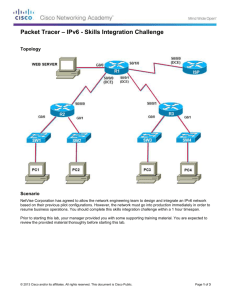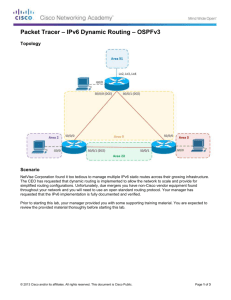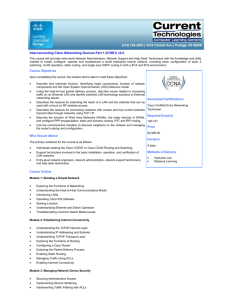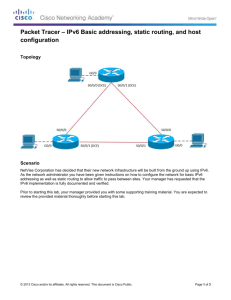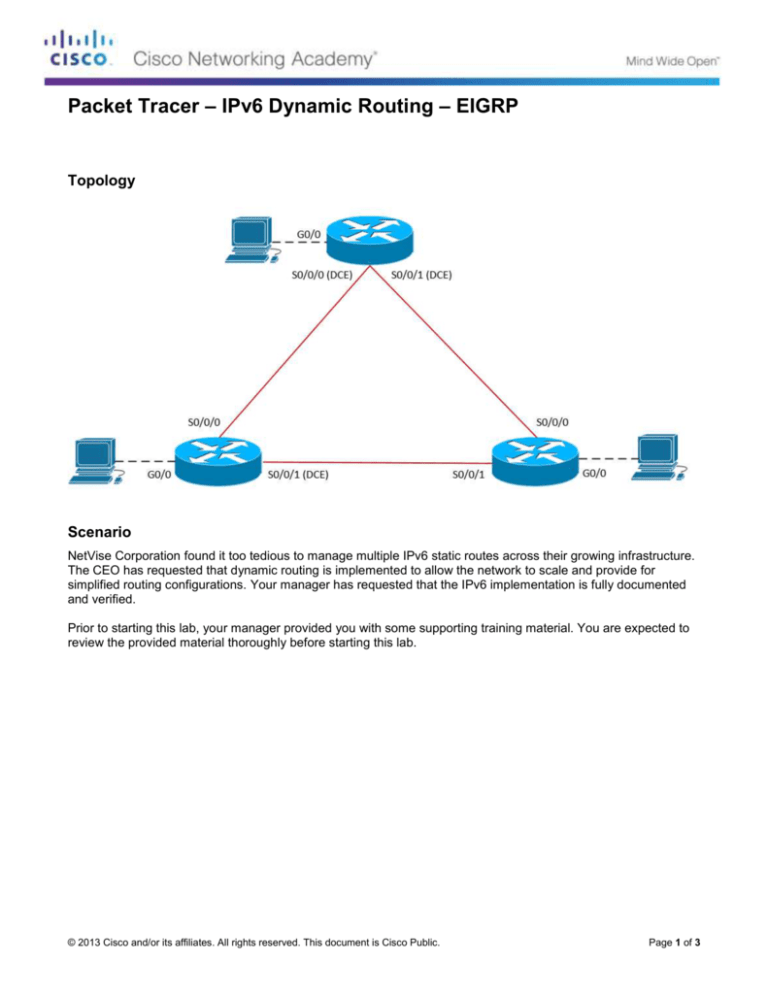
Packet Tracer – IPv6 Dynamic Routing – EIGRP
Topology
Scenario
NetVise Corporation found it too tedious to manage multiple IPv6 static routes across their growing infrastructure.
The CEO has requested that dynamic routing is implemented to allow the network to scale and provide for
simplified routing configurations. Your manager has requested that the IPv6 implementation is fully documented
and verified.
Prior to starting this lab, your manager provided you with some supporting training material. You are expected to
review the provided material thoroughly before starting this lab.
© 2013 Cisco and/or its affiliates. All rights reserved. This document is Cisco Public.
Page 1 of 3
Packet Tracer – IPv6 Dynamic Routing - EIGRP
Addressing Table
Device
Interface
S1-RTR
S1-PC
S2-RTR
S2-PC
S3-RTR
S3-PC
Type
IP Address
Prefix
Default Gateway
S0/0/0
Global Unicast
2001:cc1a:0:12::1
/64
N/A
S0/0/1
Global Unicast
2001:cc1a:0:13::1
/64
N/A
G0/0
Global Unicast
2001:cc1a:0:1::1
/64
N/A
NIC
Static
2001:cc1a:0:1::100
/64
2001:cc1a:0:1::1
S0/0/0
Global Unicast
2001:cc1a:0:12::2
/64
N/A
S0/0/1
Global Unicast
2001:cc1a:0:23::2
/64
N/A
G0/0
Global Unicast
2001:cc1a:0:2::1
/64
N/A
NIC
Static
2001:cc1a:0:2::100
/64
2001:cc1a:0:2::1
S0/0/0
Global Unicast
2001:cc1a:0:13::3
/64
N/A
S0/0/1
Global Unicast
2001:cc1a:0:23::3
/64
N/A
G0/0
Global Unicast
2001:cc1a:0:3::1
/64
N/A
NIC
Static
2001:cc1a:0:3::100
/64
2001:cc1a:0:3::1
Objectives
Enable IPv6 routing.
Configure IPv6 Global Unicast Addresses according to the address table.
Assign IPv6 addresses statically to all workstations according to the address table.
Configure dynamic routing using EIGRPv6.
o
Setting router-ids manually
o
Enable EIGRPv6 process
o
Enable EIGRPv6 on the appropriate interfaces
o
Enable EIGRPv6 passive on the appropriate interfaces
o
Propagate default route to neighbors
o
Summarize networks
Verify routing and network connectivity.
Task 1: Enable IPv6 routing and assign IPv6 addresses to the appropriate interfaces.
Step 1: Although this step is not required to assign IPv6 addresses to the interfaces, you must enable IPv6 in
order to forward IPv6 unicast datagrams (routing).
Step 2: Assign IPv6 addresses according to the table provided. For design purposes, the hub location requires
manually configured link-local addresses on all interfaces. The following configuration is a sample of one of the
configured interfaces.
© 2013 Cisco and/or its affiliates. All rights reserved. This document is Cisco Public.
Page 2 of 3
Packet Tracer – IPv6 Dynamic Routing - EIGRP
Task 2: Assign IPv6 addresses to hosts.
Step 1: S1-PC, S2-PC, and S3-PC should be statically configured.
1.
2.
PC > Config > Gateway/DNS IPv6 > Assign default gateway.
Interface > FastEthernet0 > Assign IPv6 address and gateway.
3.
Document host configuration and ping the default gateway.
Task 3: Configure dynamic routing allow all PCs to communicate using EIGRPv6.
Step 1: Enable EIGRPv6 on all routers an assign appropriate router-id, create a loopback for each /32 address.
Autonomous System Number: 99
S1-RTR: 1.1.1.1
S2-RTR: 2.2.2.2
S3-RTR: 3.3.3.3
Step 2: Enable EIGRPv6 routing for all WAN interfaces (Serial).
S1-RTR S0/0/0 & S0/0/1
S2-RTR S0/0/0 & S0/0/1
S3-RTR S0/0/0 & S0/0/1
Step 3: Enable EIGRPv6 passive interfaces for all LAN interfaces (Ethernet).
S1-RTR Lo0
S2-RTR Lo0
S3-RTR Lo0
NOTE: As of July, 2013 passive interfaces cannot be configured in packet tracer 6.0.1 for EIGRPv6.
Step 4: Propagate default route from S1-RTR to S2-RTR.
NOTE: This task can be accomplished in two different ways, either using redistribution or summary advertisements.
Step 5: Summarize the following networks sourcing from S2-RTR.
Create the following loopbacks on S2-RTR.
o Lo40: 2001:DB8:0:40::4/64
o Lo50: 2001:DB8:0:50::5/64
o Lo60: 2001:DB8:0:60::6/64
NOTE: Ensure summary configuration is applied to all outgoing interfaces, otherwise S3-RTR will learn about the
more specific routes via S1-RTR and the summary route will not be installed.
© 2013 Cisco and/or its affiliates. All rights reserved. This document is Cisco Public.
Page 3 of 3

